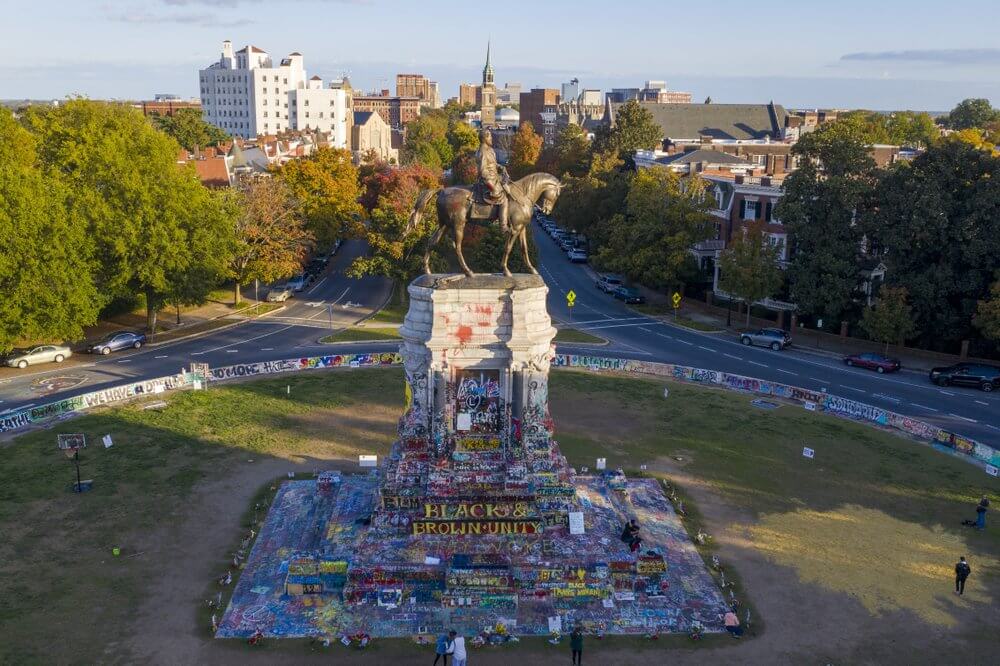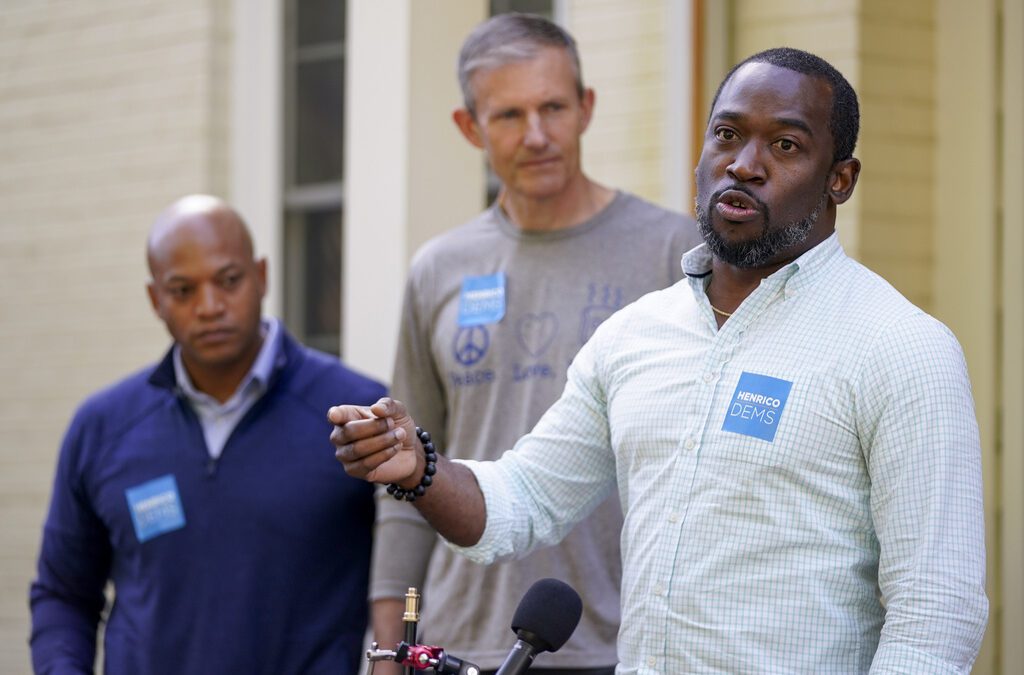
The afternoon sun illuminates the statue of Confederate General Robert E. Lee on Monument Ave in Richmond, Va., Monday, Oct. 19, 2020.
Multiple people, groups across Richmond raise issues with City Council’s Monument Avenue plan.
RICHMOND- An ordinance that would make it illegal for people to be on the medians near Marcus-David Peters Circle after sundown is making its way through the Richmond City Council. Residents and Black liberation organizers are speaking out against it.
Patroned by councilwoman Kim Gray and Mayor Levar Stoney, this bill would restrict access to a space with huge cultural significance to the city. Last Monday, the City Council pushed the bill forward. They will vote on the ordinance on Jan 11.
“It’s very important for people to have the ability to stand up to the state and speak about what they think is important to them and what their community needs,” said Kalia Harris, an organizer for the Virginia Student Power Network and a leader of the Black liberation movement in Richmond. “Clearly physically blocking that area would prohibit any organizer or regular civilian from using their first amendment right to protest in that space.”
Under this ordinance, all five medians along Allen Ave and Monument Avenue would become designated city parks. While this doesn’t include the Circle itself, it would apply to every single median around it.
Once it’s a park, no one who isn’t a police officer can be there after dark. If caught, they could face a $250 fine.
Kim Gray Calls Protesters ‘Terrorists’
While this ordinance would affect residents too, advocates suspect Gray was targeting protesters. Gray has had a long history of derogatory statements against them.
A few months ago, the councilwoman compared Richmond’s Black Lives Matter protesters to “terrorists”. In response, the protesters demonstrated outside her home, reading out a list of demands, including reopening the Marcus-David Peters case. Since then, Gray’s attempted to deter protesters from the Circle.
“Kim Gray has been asking for us to be tear gassed and arrested and brutalized by the police,” said Harris. “And has helped to get legislation passed in the City Council that only helps the police continue to brutalize us. So it’s not her that should be leading this charge at all,” Harris said.
In July, Kim Gray insisted that RPD up their police presence in the Circle, saying that protesters were “defecating in the street” and “having sex on top of cars”. One day later, Richmond Police’s new police chief announced a plan to assign more officers to patrol the Circle.
On a legislative level, Gray voted was against a non-lethal weapons ban against protesters, even though tear gas and rubber bullets can cause serious harm.
“If this [resolution] moves forward, we remove non-lethal options from the arsenal that police have, and we go straight to hands-on contact and/or lethal intervention,” Gray said.
Objections to Monument Avenue Park
Lawrence West, founder of BLM RVA, guesses that Gray is responding to complaints of a select few Monument Avenue residents. West says most of the residents support the protests, from his experience.
“A lot of people on Monument want us there because they feel like this space is safer with us there,” said West. “So, those people that were crying out to Kim Gray were a select few. They weren’t even all of her constituents because some of her constituents wanted to come to the monuments to see it firsthand. They thought it was cool. And, they look at what was going on and they say this is a part of America’s history.”
Several residents of Monument Avenue wrote letters to the City Council, saying they also do not support the proposed ordinance.
“I live one block from Monument Avenue and have, for years, taken evening strolls down the median,” said resident Doug Allen in a letter. “If this ordinance is passed, that would now be a criminal act. Please ask yourselves if turning an evening stroll down an avenue into a Class 4 misdemeanor is a good planning decision.”
No residents of Monument Avenue wrote to the council in favor of the proposed ordinance. Three residents wrote in opposition to it. Three organizations, the Historic West Grace Street Association, the Fan District Association, and the Monument Avenue Preservation Society did express support for it.
Community Care on Monument Avenue
But it’s not just protests happening in the Circle. Many community members have banded together to help one another in the midst of the pandemic from inside the headquarters of the city’s Black liberation movement.
Ray and Bubbles Dawkins have been feeding, clothing and seeking shelter for houseless people, using the Circle and the surrounding area as their home base for months.
The Kitchen has faced repeated harassment by the Richmond and Capitol police since protests began in May. Several of their events, including a coat drive, have been torn down and destroyed by these agencies. According to West, they are facing persecution by police for something they should be applauded for.
“(The police) understand that when the Red Cross shows up into a disaster area and starts spreading out and giving out food,” said West. “They don’t go in and bash them upside the head.They don’t push them and take down their tables and their trays. That would be on the front page of Richmond Times.”
If the City Council passes this ordinance, West and other advocates worry that this harassment would only get worse.
“We’ve got the whole situation where our voices are and our rights are not even being respected,” said West. “How can you punish people who’re trying to solve the problem you’re supposed to solve?”
READ MORE: ‘The Kitchen’ Is Feeding Everyone on the Front Lines of Richmond Protests
Significance of the Circle on Monument
Since the death of George Floyd in May, Marcus-David Peters Circle has become a center for protesters to fight for Black liberation and against racial discrimination.
Formally the home of Virginia’s largest symbol to the Confederacy, Black Richmonders have reclaimed and transformed it into a symbol of hope and liberation.
“I think that Richmond, Virginia and all of the world have noticed what has happened here and how oppressive that figures and symbols have been in America for a very long time,” said West. “And so it, it just goes to show that what’s happening here is just as significant as the fall of the Confederacy itself. “
The New York Times rated the Circle the most influential work of American protest art since WWII earlier this year.

The Case of Marcus-David Peters
But even outside the monument, the space’s new name holds so much significance. A Richmond police officer killed Marcus-David Peters, who was experiencing his first mental health episode at the time, in 2018. Last month, the killing was found by the Richmond Commonwealth’s Attorney to be justified.
RELATED: Commonwealth’s Attorney Refuses to Reopen Marcus-David Peters Investigation
“That name just carries so much meaning as someone who was killed by the Richmond Police Department, whose family has not seen justice,” said Harris. “Their demands are that the officer was fired, but also that the police department was defunded and that his case was reopened. And none of those things have happened, even though legislation like the Marcus alert has come to pass in the General Assembly.”
The Marcus Alert, which was signed by Governor Northam earlier this year, has come under fire for being an “ineffective form” of police reform from Peters’ own sister, Princess Blanding.
Not allowing people to protest at this space in particular is very telling about the city council’s priorities, said Harris. Harris also pointed out that there are several other spaces in the city that could benefit from a park.
“If (Kim Gray) actually wanted to do something that was meaningful or intentional, they’d partner with people like the Virginia Defenders or folks in the city that are doing work around land preservation and green space,” said Harris. “There’s folks in Southside that are doing this. I would have been happy to get together on a bill and make a park in a place where the people have asked for it.”
READ MORE: Marcus Alert Offers Lifesaving Care ‘When Feasible’
Access to the Circle Already Restricted
If passed, this bill would allow the city to add more rules restricting access to the medians on Monument Avenue.
The state’s Capitol Police has jurisdiction over the Circle, which officially closes at sundown.
Currently, the Capitol Police is enforcing new rules in Marcus-David Peters Circle. These rules ban everything from distributing fliers to holding fundraisers in the Circle. Where those rules came from remains a mystery.
While the Capitol Police are the ones in charge, it hasn’t stopped Richmond police and the State police from tear gassing, beating and shooting rubber bullets at protesters there. These attacks by law enforcement on Black liberation protesters have occurred both during the day and after sundown.
READ MORE: Who Made The Rules? Capitol Police Won’t Say Where New Orders Came From
The History of Sundown Towns
Unfortunately, sundown curfews are not a new thing to Virginia. Its history, unsurprisingly, has roots in racism.
In the ‘60s these restrictions worked to prevent Black people from being in white areas after dark. If caught, the consequences could be deadly.
“Sundown towns back in the day where black people couldn’t be out or in certain towns after sundown,” said Harris. “You could get locked up. You could get lynched. A lot of things could happen to you. And it was permissible by law essentially. There is a large history in Richmond specifically.”
Back in the 1940s, Colonial Heights, only 23 miles away from Richmond, was a suspected sundown town. According to historian James W. Loewen, a popular saying known among nearby Richmond whites at the time was “Nothing but whites in Colonial Heights.” The town was also nicknamed ‘Colonial Whites’ by white people at the time.
Similarly, many of the now-removed monuments to the Confederacy on Monument Avenue were put up to intimidate Black people. We have a story detailing their history and efforts by the governor to remove them here.
Historian Tyler Wisewan was horrified when she heard about the ordinance. She wrote a letter to the council, hoping to change council members’ minds. While also calling out the country’s history with curfew laws, she pointed out how these laws seldom work.
“Even more pertinent, enacting curfew laws during times of unrest has only proven to cause more unrest and tension,” wrote Wiseman. “Curfews don’t work.”
A Curfew Hasn’t Worked in the Past
If Stoney and Gray think a curfew will stop protesters from organizing in Richmond, they have a short memory.
On May 31, Stoney put in place a 8 p.m. curfew in response to protests for Black liberation in Richmond. The next day, Richmond police tear gassed protesters gathered in the Circle, half an hour before the curfew began.
The protests only ramped up following that attack, continuing for months after the curfew was lifted.
We reached out to Kim Gray and Mayor Stoney’s offices for a comment on this story. We have not received a response from either office.
How You Can Support Black Liberation
If you’d like to learn more about BLM RVA, feel free to visit their website. They’re currently working on a program called “Vocation not Incarceration”, which will create employment opportunities for formerly incarcerated people.
You can also donate to the Kitchen on Cash App, under the username $redyray.
If you’d like to contact your district’s City Council member about this issue, this website has their contact information. You can also send Mayor Stoney an email through this application.
Arianna Coghill is a content producer with the Dogwood. You can reach her at [email protected]
Politics

Biden administration bans noncompete clauses for workers
The Federal Trade Commission (FTC) voted on Tuesday to ban noncompete agreements—those pesky clauses that employers often force their workers to...

Democratic shakeup in Virginia primaries for governor, lieutenant governor
Richmond Mayor Levar Stoney quit his bid for governor and jumped into the race to be the Democratic nominee for lieutenant governor. The race for...
Local News

The zodiac signs of 12 iconic women offer insight into their historic accomplishments
Zodiac signs can tell you a lot about someone’s personality. Whether they’re an earth, water, air, or fire sign, these 12 categories (which are...

Virginia verses: Celebrating 5 poetic icons for National Poetry Month
There’s no shortage of great writers when it comes to our commonwealth. From the haunting verses of Edgar Allan Poe, who found solace in Richmond's...




